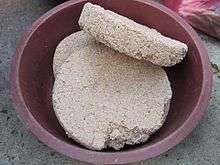Nuruk

Nuruk (누룩) is a traditional Korean fermentation starter.[1][2][3][4] It imparts a unique flavor to Korean food[5] and is used to make different types of Korean alcoholic beverages including takju, cheongju, and soju.[3] It is an essential ingredient in Shindari and is mixed with rice (Nowicki 22).[6] Historically, it was used in a variety of provinces of Korea, including Jeju Island.
Wheat, rice (of both the glutinous and non-glutinous types), and barley are used to make nuruk, either as whole grain or in the form of grits or flour.[2][7] The dry grain is moistened, shaped into a large cake, and hung up to ferment for 2‒4 weeks in an ondol room.[2][3][7] The cake matures at a precise temperature until a mold forms.[3]
Origin
Chinese history records the first use of nuruk in Korea in 1123 CE.[8] Similar fermentation starter was first made in China during the Warring States period beginning in the 5th century BCE, and nuruk has been used in Korea since the period of the Three Kingdoms in the 3rd century CE.
Traditionally, nuruk was prepared on a small scale by families in summer or autumn, especially in July when the ambient temperature is between 20–30 °C (68–86 °F) on the Korean peninsula.[2][7] It has been mass-produced in factories since the 1920s.[9]
Fermentation process
Fermentation is a metabolic process in which an organism converts carbohydrate, such as a sugar, into an alcohol or an acid. Fermentation is an anaerobic process (Nowicki 2),[6] meaning the living organisms involved in this process do not require oxygen to breathe. A small amount of ATP can be produced without oxygen. Wine, beer, and yogurt are produced through fermentation. In Korea, popular fermented foods include “Kimchi” and soybean paste. If the result is harmful or smelly, it is called "spoilage," but if it is useful, then it is called "fermentation."[10]
Chemically, it contains 2,6-Dimethoxybenzoquinone (2,6-DMBQ), also found in fermented wheat germ extract.[11] Microorganisms present in nuruk include Aspergillus, Rhizopus, and yeasts.[2][7] Together with yeast, nuruk is used in rice alcohol production in Korea, as it provides the enzyme amylase.[3]
Korea has four seasons with distinct temperature and humidity. Summer, with high temperature and humidity, is best for farming.[12] Even when the sweet fruit of the west was unavailable, staple grains including rice and barley made it easy to produce and distribute the mold necessary for nuruk.
Health benefits
Fermented foods provide friendly organisms for the flora across the digestive system that are necessary for normal digestive function and protect the flora of gut from harmful organisms. Fermented foods also have been broken down or “pre-digested" and therefore, unlike ordinary carbohydrates, place a lighter burden on the digestion system. They have many additional benefits (Helmenstine 25-28).[10] Fermented food and drink such as Shindari are said to improve the immune system, prevent cancer, and increase beneficial bacteria in the digestive system, balancing the production of stomach acid and aiding nutrient absorption.[13] Traditional fermented food helps the body to produce acetylcholine. It is especially beneficial for people with diabetes.
References
- ↑ "Fermented Cereals a Global Perspective. Chapter 3." Fermented Cereals a Global Perspective. Chapter 3. Web. 04 Mar. 2016.
- 1 2 3 4 5 Lee, Cherl-Ho (1999). "Cereal Fermentations in Countries of the Asia-Pacific Region". In Haard, Norman F.; Odunfa, S.A.; Lee, Cherl-Ho; Quintero-Ramírez, R.; Lorence-Quiñones, Argelia; Wacher-Radarte, Carmen. Fermented cereals : a global perspective. FAO Agricultural Services Bulletin. Rome: Food and Agriculture Organization. p. 91. ISBN 92-5-104296-9. ISSN 1010-1365. Retrieved 19 June 2017.
- 1 2 3 4 5 Shin, Dong-Hwa; Kim, Young-Myoung; Park, Wan-Soo; Kim, Jae-Ho (2016). "Ethnic Fermented Foods and Beverages of Korea". In Tamang, Jyoti Prakash. Ethnic Fermented Foods and Alcoholic Beverages of Asia. India: Springer. p. 298. Retrieved 23 September 2017.
- ↑ McKay, Marianne; Buglass, Alan J.; Lee, Chang Gook (2011). "Fermented Beverages: Beers, Ciders, Wines and Related Drinks". In Buglass, Alan J. Handbook of Alcoholic Beverages: Technical, Analytical and Nutritional Aspects. Chichester, UK: Wiley. pp. 214–216. ISBN 978-0-470-51202-9. Retrieved 23 September 2017.
- ↑ Yoo, Jong-Gil. Nuruk, a Traditional Korean Fermentation Starter, contains the Bioactive Compound 2,6-dimethoxy-1,4-benzoquinone (2,6-DMBQ). Online.
- 1 2 Nowicki, Stephen. Holt McDougal Biology. Orlando, FL: Holt McDougal, 2012. Print.
- 1 2 3 4 Yokotsuka, T. (1985). "Fermented protein foods in the Orient, with emphasis on shoyu and miso in Japan". In Wood, Brian J. B. Microbiology of Fermented Foods. 1. London: Elsevier Applied Science Publishers. pp. 197–247. ISBN 978-1-4613-7990-4.
- ↑ "전통누룩의 역사". terms.naver.com. Retrieved 2016-03-16.
- ↑ "Nuruk, a Traditional Korean Fermentation Starter, Contains the Bioactive." Ve Compound 2,6-dimethoxy-1,4-benzoquinone (2,6-DMBQ). Web. 16 Mar. 2016.
- 1 2 Helmenstine, Ph.D. Anne Marie. "What Is Fermentation?"Chemistry.about.com., 29 Nov. 2014. Web. 05 Mar. 2015.
- ↑ "누룩". terms.naver.com. Retrieved 2016-03-16.
- ↑ Nuruk, a Traditional Korean Fermentation Starter, Contains the Bioactive."Ve Compound 2,6-dimethoxy-1,4-benzoquinone (2,6-DMBQ), 01 Oct. 2011. Web. 05 Mar. 2015.
- ↑ "Mycoflora Dynamics Analysis of Korean Traditional Wheat-based Nuruk." - Springer. Web. 04 Mar. 2016.